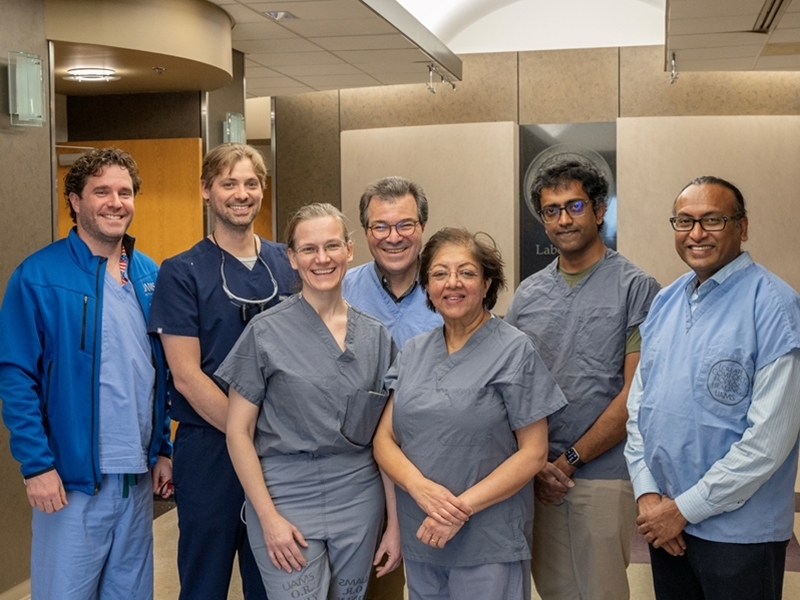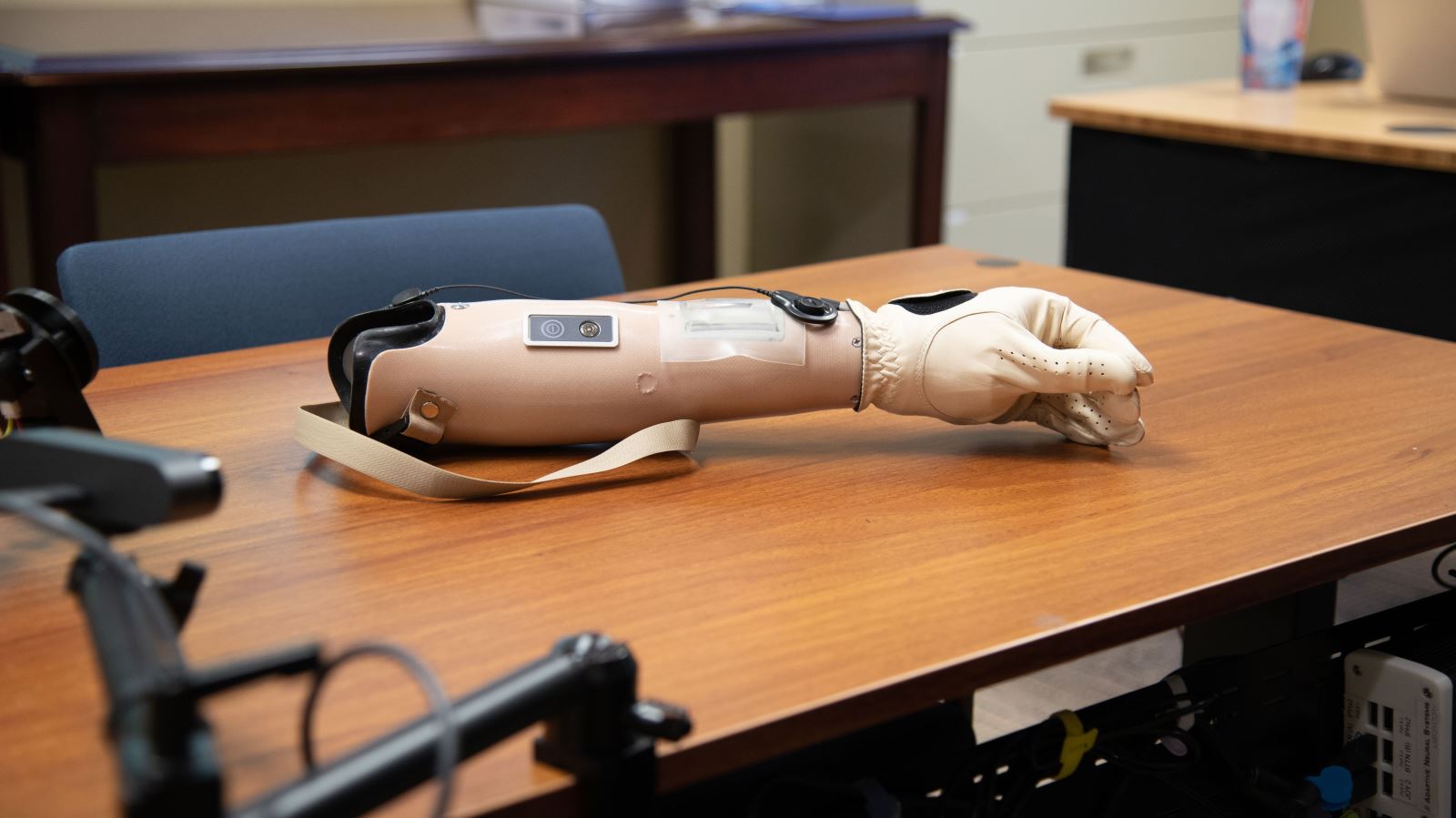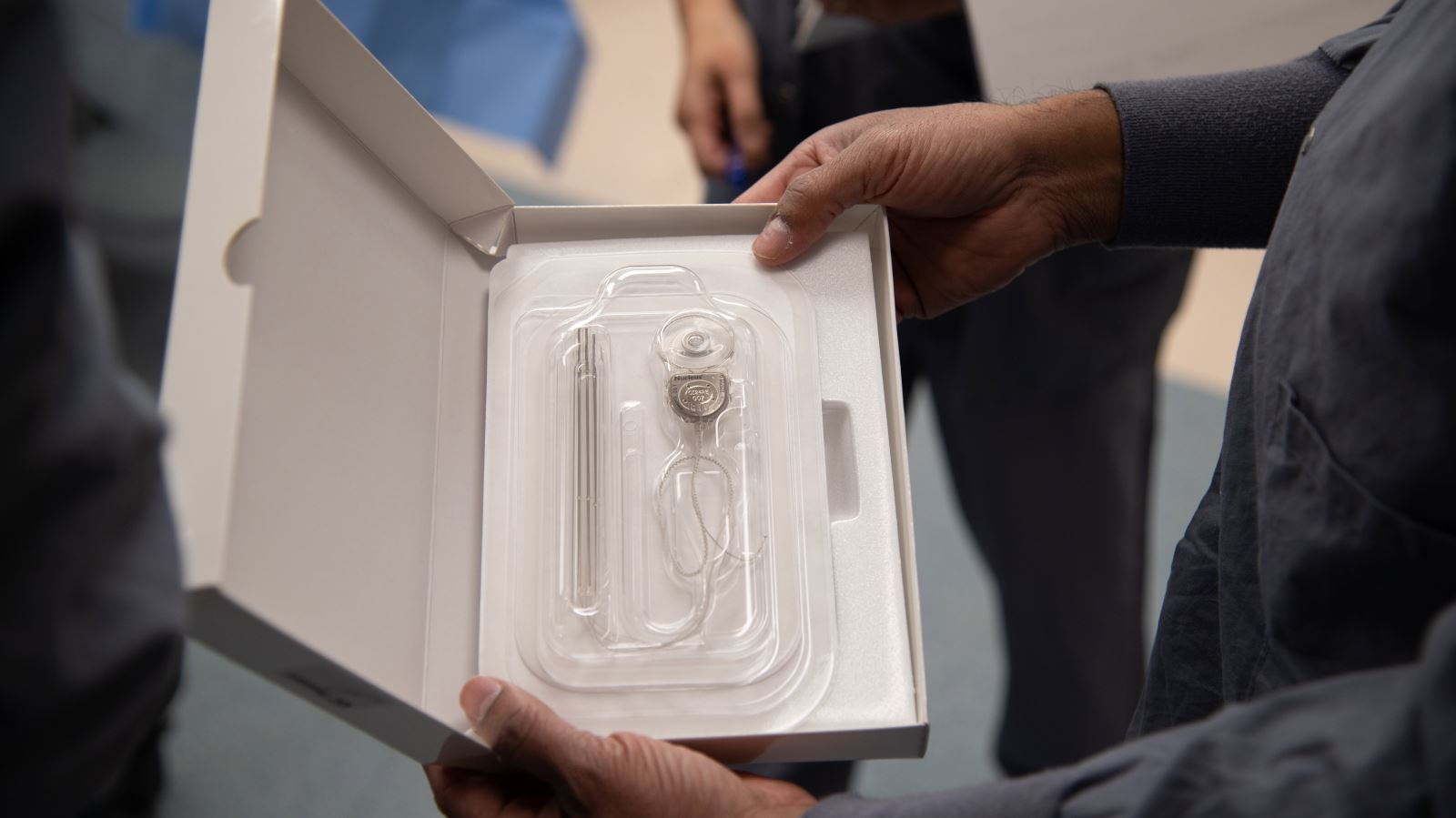
LITTLE ROCK — The first Arkansan, and only the second person in the world, has received an innovative prosthetic hand developed by researchers at the Institute for Integrative and Innovative Research (I³R), which restores a meaningful sense of touch and grip force following surgery at the University of Arkansas for Medical Sciences.
The lengthy and detailed operation was led by neurosurgeon Erika Petersen, M.D., with co-leading roles for orthopaedic hand and nerve specialists John Bracey, M.D., and Mark Tait, M.D.
“The surgery went really well,” said Petersen, also a pioneer in the implantation of nerve stimulators for pain and movement disorders. “It’s a great achievement for UAMS, the University of Arkansas and our state. It’s also an exciting promise of what’s to come for people with amputations around the globe.”
The neural-enhanced prosthetic was invented and developed with funding from the National Institutes of Health by an engineering team led by Ranu Jung, Ph.D., and James Abbas, Ph.D., from the U of A Institute for Integrative and Innovative Research while serving as faculty researchers at Florida International University and Arizona State University. It has received FDA investigational device exemption status, an effort led by Sathyakumar Kuntaegowdanahalli, Ph.D. The leading-edge device was also used in the first surgery of its kind, which was performed in Florida.
 |
| The prosthetic hand system used with the Implantable Stimulator Recorder. |
As part of the Arkansas collaboration, the step-by-step implant procedure developed by the I³R team was displayed on a large screen during the surgery, and the team was on hand to provide clarification, as needed.
The clinical trial participant, whose identity remains confidential in accordance with clinical trial guidelines, has been learning to use the neural-enabled prosthesis at the University of Arkansas, Fayetteville with the I³R team since recovering from the January surgery.
The prosthesis technology significantly advances the ability to harness the power of the human nervous system, said Petersen, a professor and director of the Section of Functional and Restorative Neurosurgery in the College of Medicine Department of Neurosurgery.
“Drs. Jung and Abbas and their team have opened the door to a new era of augmenting people’s ability to function in the world,” she said. “We are grateful they chose us as collaborators.”
Abbas, who has a joint appointment with UAMS in the Department of Neurosurgery, led discussions that brought the team of UAMS surgeons, Snell Prosthetics and Orthotics and health technology companies together with I³R’s Adaptive Neural Systems Group (ANS). The UAMS Translational Research Institute has also facilitated collaboration on the study, “Neural Enabled Prosthesis for Upper Limb Amputees."
“As researchers pioneering innovations to make a positive societal impact, we need academic and industry partners who are on the leading edge with us,” Abbas said. “Our collaboration with UAMS and Snell is an example of the type of innovative work that is happening in Arkansas.”
THE SURGERY
Petersen, Bracey and Tait used their complementary expertise to implant 15 microelectrodes and other components that are part of the Jung-Abbas device and which enable communication between the brain and the prosthesis through the arm’s median and ulnar nerves.
Bracey and Tait had the specialized task of implanting the thinner-than-human-hair filament wires into the patient’s nerves. The job was a perfect fit for the unique duo, surgical partners throughout their residency, surgical specialty fellowship training and their UAMS practice.
Preparation for the surgery included training and practice with the I3R team, including on a human cadaver at UAMS. During the surgery, Bracey and Tait worked quietly as they sat across from each other using a surgical microscope positioned above the patient’s left arm.
“We’re really in tune, and sometimes we communicate without even talking,” said Bracey, an assistant professor in the College of Medicine Department of Orthopaedic Surgery.
“This surgery was a little bit sneaky hard, but Dr. Bracey and I have been operating together for so long that it came to us very easily and naturally,” said Tait, an associate professor in the Department of Orthopaedic Surgery. “And when issues arose, we weren't frazzled; we just worked through them and figured it out.”
 |
| The Implantable Stimulator Recorder invented by researchers at I³R. |
Bracey and Tait accessed the median and ulnar nerves on the inside of the arm, and Petersen worked through an incision on the outside of the arm.
As the expert in neuromodulation, Petersen ensured that the neurostimulator portion of the device was placed appropriately. The neurostimulator receives commands from the prosthesis-mounted components and produces electrical pulses that get conveyed to the patient’s nervous system, enabling the sense of touch.
“From my perspective, the surgery went very smoothly, and I was impressed with the level of teamwork and collaboration by everyone involved,” Jung said. “I’m pleased that with this second successful surgery, we’re taking another step forward toward broad deployment of this life-improving technology.”
Bracey and Tait work with many individuals with amputations, and they have dreamed about such a breakthrough.
“The idea of enabling someone to feel with their prosthesis is pretty meaningful, and we’re excited to be part of this groundbreaking project with Drs. Jung and Abbas and the I³R team,” Tait said.
This project was supported in part by the National Institute of Biomedical Imaging and Bioengineering of the National Institutes of Health under Award Number R01EB023261.
The Translational Research Institute is supported by the NIH National Center for Advancing Translational Sciences, Clinical and Translational Science Award UL1 TR003107.
About the Institute for Integrative and Innovation Research (I³R): Established through a $194.7 million gift from the Walton Family Charitable Support Foundation, the University of Arkansas Institute for Integrative and Innovative Research pioneers solutions to wicked problems through convergent research across academic, industry, government, and non-profit sectors to make a positive societal impact by creating and deploying innovations to scale. Learn more at i3r.uark.edu.
About UAMS: UAMS is the state's only health sciences university, with colleges of Medicine, Nursing, Pharmacy, Health Professions and Public Health; a graduate school; a hospital; a main campus in Little Rock; a Northwest Arkansas regional campus in Fayetteville; a statewide network of regional campuses; and seven institutes: the Winthrop P. Rockefeller Cancer Institute, Jackson T. Stephens Spine & Neurosciences Institute, Harvey & Bernice Jones Eye Institute, Psychiatric Research Institute, Donald W. Reynolds Institute on Aging, Translational Research Institute and Institute for Digital Health & Innovation. UAMS includes UAMS Health, a statewide health system that encompasses all of UAMS' clinical enterprise. UAMS is the only adult Level 1 trauma center in the state. UAMS has 3,240 students, 913 medical residents and fellows, and five dental residents. It is the state's largest public employer with more than 11,000 employees, including 1,200 physicians who provide care to patients at UAMS, its regional campuses, Arkansas Children's, the VA Medical Center and Baptist Health. Visit www.uams.edu or www.uamshealth.com. Find us on Facebook, Twitter, YouTube or Instagram.
About the University of Arkansas: As Arkansas' flagship institution, the U of A provides an internationally competitive education in more than 200 academic programs. Founded in 1871, the U of A contributes more than $2.2 billion to Arkansas’ economy through the teaching of new knowledge and skills, entrepreneurship and job development, discovery through research and creative activity while also providing training for professional disciplines. The Carnegie Foundation classifies the U of A among the few U.S. colleges and universities with the highest level of research activity. U.S. News & World Report ranks the U of A among the top public universities in the nation. See how the U of A works to build a better world at Arkansas Research and Economic Development News.
Topics
Contacts
Delia Garcia, director of strategic communications and engagement
Institute for Integrative and Innovative Research
479-718-3328, deliag@uark.edu
Leslie W. Taylor, vice chancellor of communications and marketing
University of Arkansas for Medical Sciences
501-686-8998, leslie@uams.edu